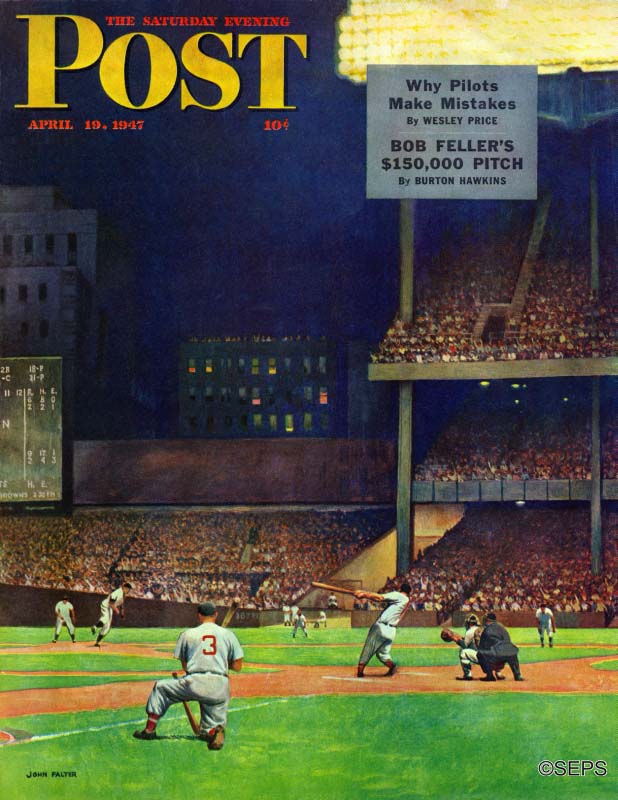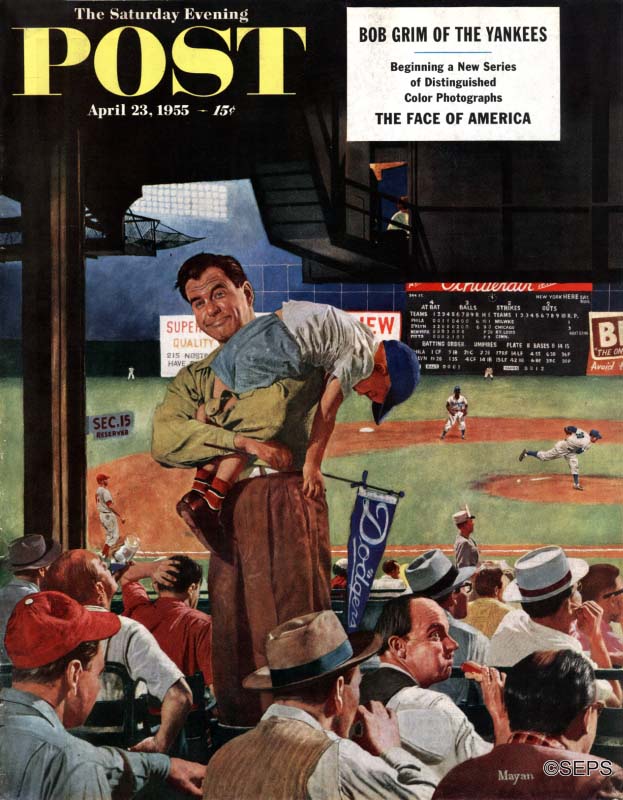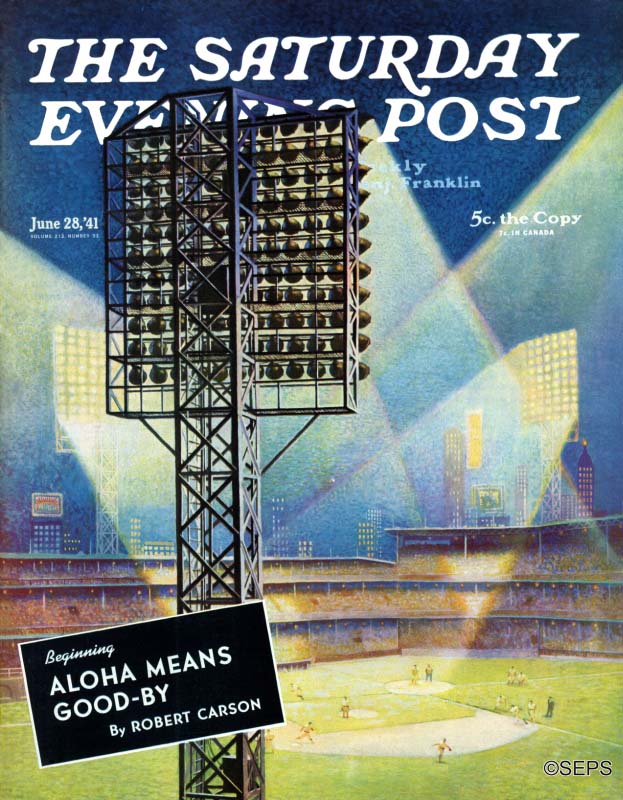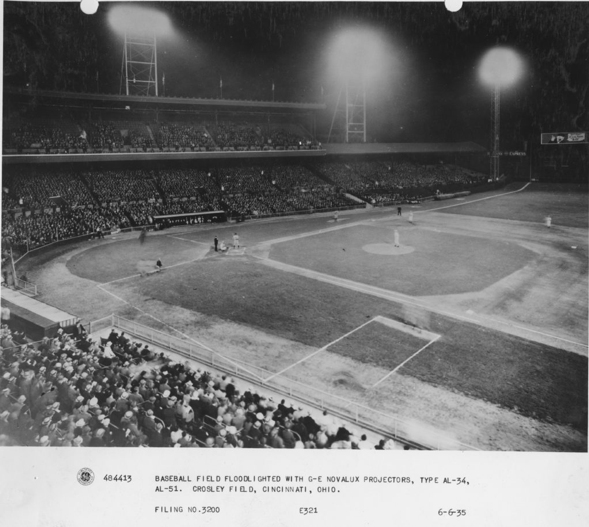Let There Be Light on the Baseball Diamond
There is something majestic about the electric green glow of the baseball diamond at night, the rush of the cool evening air and the moon bowing its silver face over the stadium rafters. Night games help fans escape the worries of work and life, and The Saturday Evening Post’s artists were there to capture the glory of those first illuminated games that transformed the pastime of baseball.


The first-ever professional baseball game played under “permanent lights” took place May 2, 1930, when a Des Moines, Iowa, team hosted Wichita for a Western League game. The game drew 12,000 people at a time when the team typically attracted a couple hundred fans per game. Those first “nighters” debuted in an era when a tiny fraction of American farms had electricity; lighted games in small towns helped struggling teams survive during the Depression; they allowed farmers, factory workers, teachers, civil servants, and policemen to attend games after an exhausting work day when the entire country was trying to rebuild the economy.

On the evening of May 24, 1935, the Cincinnati Reds were scheduled to face the Philadelphia Phillies in Major League Baseball’s first night game, played under lights installed by the City at Crosley Field in Cincinnati. Initially, some baseball executives frowned on the prospect of America’s best baseball being played under artificial lights. In Washington, President Franklin Delano Roosevelt punched a button from his desk firing more than one million watts of electricity to bathe the field in light. Ford Frick, President of the National League, threw out the first pitch of the game before 20,422 fans who munched on hot dogs and popcorn and watched the Reds beat the Phillies 2-1.

Today, more than 80 percent of all Major League Baseball games are played after the sun goes down.
Memories of those games are fresh in the minds of Big Leaguers who came up in the ’40s and ’50s. Philadelphia Phillies’ pitcher Robert “Bob” Miller, age 92, is a U.S. Army veteran and one of two surviving members of the “Whiz Kids,” the young team that unexpectedly made it to the 1950 World Series against the New York Yankees. Thinking back to those nighters, Bob says the lights were pretty darn good. “You could see a pitch … catch a fly ball.” But when the sun went down in cities like San Francisco and Philadelphia, it got cold pretty fast, and he would put on an overcoat. The schedules changed too. Bob recalls, “The team ate dinner around 2. After the game we may have had a beer or two. Then it was midnight and I loved every minute of it. After all, I was in the Big Leagues and how can you not like that!”
Feature image: The first Major League night game , in Cincinnati, Ohio. (GE)
Don’t Make Waves
Like many kids, my first visit to a major league ballpark was with my father. I was about 10 or 11, and the Philadelphia Phillies were playing a day game at the old Connie Mack Stadium. I’d watched games on TV — my Dad was a die-hard Phillies fan — but they hadn’t prepared me for this. I was enchanted by the ballpark: the sound and bustle of the crowd, the smell of peanuts (and cigars in that era), the manicured field glowing green in the summer sunlight, the crack of bat against ball, the huge Ballantine’s Beer sign over the scoreboard, the hot dogs for a quarter. Above all, the sight of my dad enjoying himself and rooting for his team.
I don’t remember who won that afternoon. I would guess the Phils lost; they were a terrible team in the late ’50s. It didn’t matter. I was hooked. This was the way to enjoy baseball — in the stands along with other like-minded fans who came to savor the game in its slow-paced purity.
Once I was able to buy my own tickets, I went to as many games as possible, at least three or four a season, wherever I happened to be living. I’ve been to two World Series games (both in New York), and I’ve been lucky to have friends with season seats (excellent ones in Los Angeles). Attending a ballgame became akin to a sacred ritual, with the ballpark the local cathedral dedicated to the Great American Pastime. Every spring, I would peruse the new schedule and assess which home games would be the most fun to catch.
Not this year.
Instead of going to the ballpark, I plan to keep score in front of the HD big-screen in the comfort of my home, where I can whip up a plate of nachos, grab a beer from the refrigerator, and don’t have to stand in line to use the bathroom.
What happened? Simply put, the experience has been ruined.
For starters, going to a big league ballgame nowadays requires a major financial commitment. Tally up the costs of a good seat (say, field level along the third base line), parking ($20), food ($6 a hot dog), and drink ($8 a beer), and you’re looking at maybe $120 for an afternoon or evening’s entertainment. To bring the family along, you might need to take out a loan.
But this isn’t about the money. I am still willing to pony up the necessary funds to see two competitive teams battle it out, maybe once or twice a year.
No, it’s the fans today who have turned me off. Take the chuckleheads who insist on starting the wave for no apparent reason, creating a distraction from the game at hand. My question to them: If you’d rather leap up every 15 seconds with your arms flapping in the air than pay attention to what’s happening on the field, why are you there? The same goes for those benighted individuals who spend almost the entire game staring into their smartphones or taking selfies, oblivious to the incredible catch in left field.
But the worst development in fan misbehavior is the stand-during-every-play crowd. They give a new meaning to “standing room only.”
Whenever the count gets close or there are men on base, they rise to their feet and start clapping and roaring, blocking the view of those of us who prefer to watch from our seats. Children and short people are left to their imaginations.
Hey, I’m all for enthusiasm. I stand and clap and roar for a big hit or crucial strikeout along with the best of them, but I didn’t shell out a small fortune to look at someone’s backside for most of the game.
Here’s what I propose: Aside from standing to sing the national anthem, fans should be prohibited from standing for more than one play an inning. Until the seventh inning, that is, after which they can stand as much as they darn please. And anyone caught doing the wave will be asked to leave the premises.
Sadly, that’ll never happen. So this baseball season, you’ll find me at home, where the beers are free, the food is mere steps away, and nobody is standing between me and the game on TV.